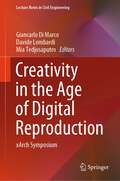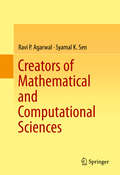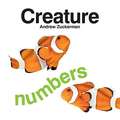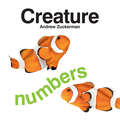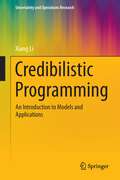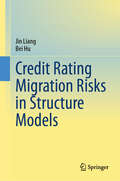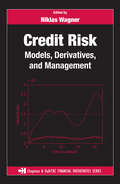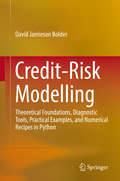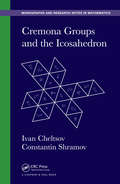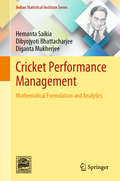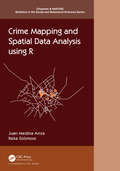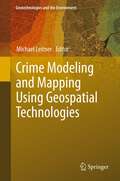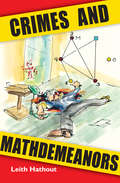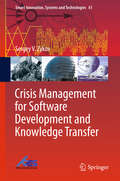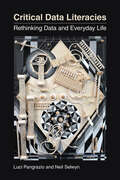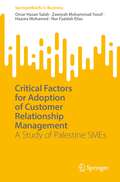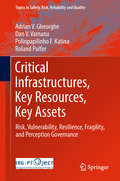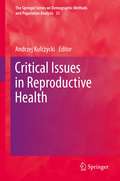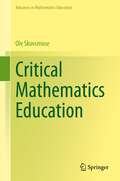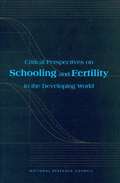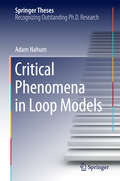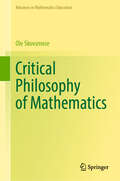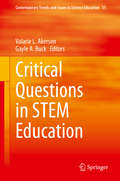- Table View
- List View
Creativity in the Age of Digital Reproduction: xArch Symposium (Lecture Notes in Civil Engineering #343)
by Davide Lombardi Giancarlo Di Marco Mia TedjosaputroInspired by this symposium we would like to rethink and provide an insight about the use of new technologies in architecture and design. The consideration spans over (but not limited to) computational design, virtual experience, digital fabrication, artificial intelligence and sustainability/environment. Readers of the proceedings will benefit from discussions on how adoption of new technologies can benefit the Construction Industry rather than just for the sake of leveraging new technologies. The book targets scholars and high-education level students, as well as Ph.D.s which research falls into the broad realm of digital design.
Creators of Intelligence: Industry secrets from AI leaders that you can easily apply to advance your data science career
by John K. Thompson Dr. Alex AnticGet your hands on the secret recipe for a rewarding career in data science from 18 AI leadersPurchase of the print or Kindle book includes a free PDF eBookKey FeaturesGain access to insights and expertise from data science leaders shared in one-on-one interviewsGet pragmatic advice on how to become a successful data scientist and data science leaderReceive guidance to overcome common pitfalls and challenges and ensure your projects' successBook DescriptionA Gartner prediction in 2018 led to numerous articles stating that "85% of AI and machine learning projects fail to deliver.” Although it's unclear whether a mass extinction event occurred for AI implementations at the end of 2022, the question remains: how can I ensure that my project delivers value and doesn't become a statistic? The demand for data scientists has only grown since 2015, when they were dubbed the new “rock stars” of business. But how can you become a data science rock star? As a new senior data leader, how can you build and manage a productive team? And what is the path to becoming a chief data officer? Creators of Intelligence is a collection of in-depth, one-on-one interviews where Dr. Alex Antic, a recognized data science leader, explores the answers to these questions and more with some of the world's leading data science leaders and CDOs. Interviews with: Cortnie Abercrombie, Edward Santow, Kshira Saagar, Charles Martin, Petar Velickovic, Kathleen Maley, Kirk Borne, Nikolaj Van Omme, Jason Tamara Widjaja, Jon Whittle, Althea Davis, Igor Halperin, Christina Stathopoulos, Angshuman Ghosh, Maria Milosavljevic, Dr. Meri Rosich, Dat Tran, and Stephane Doyen.What you will learnFind out where to start with AI ethics and how to evolve from frameworks to practiceDiscover tips on building and managing a data science teamReceive advice for organizations seeking to build or mature a data science capabilityStop beating your head against a brick wall – pick the environment that'll support your successRead stories from successful data leaders as they reflect on the successes and failures in data strategy developmentUnderstand how business areas can best work with data science teams to drive business valueWho this book is forThis book is for a wide range of audience, from people working in the data science industry through to data science leaders and chief data officers. This book will also cater to senior business leaders interested in learning how data and analytics are used to support decision-making in different domains and sectors. Students contemplating a career in artificial intelligence (AI) and the broader data sector will also find this book useful, along with anyone developing and delivering university-level education, including undergraduate, postgraduate, and executive programs.
Creators of Mathematical and Computational Sciences
by Ravi P Agarwal Syamal K SenThe book records the essential discoveries of mathematical and computational scientists in chronological order, following the birth of ideas on the basis of prior ideas ad infinitum. The authors document the winding path of mathematical scholarship throughout history, and most importantly, the thought process of each individual that resulted in the mastery of their subject. The book implicitly addresses the nature and character of every scientist as one tries to understand their visible actions in both adverse and congenial environments. The authors hope that this will enable the reader to understand their mode of thinking, and perhaps even to emulate their virtues in life.
Creature Numbers
by Andrew ZuckermanLearn the rainbow with red snakes, orange fish, and yellow birds. Learn to count as two scorpions fight, four penguins waddle, and nine ants work. Andrew Zuckerman's vivid pictures of fascinating animals from around the world will enthrall young readers and teach basic colors and numbers in a celebration of nature in two books that bring the wildly successful photographer's work to a whole new audience. The up-close and personal photos of everyone's favorite animals make these board books perfect educational tools for any child, and stunning works of art for animal lovers of all ages.
Creature Numbers
by Andrew ZuckermanLearn the rainbow with red snakes, orange fish, and yellow birds. Learn to count as two scorpions fight, four penguins waddle, and nine ants work. Andrew Zuckerman's vivid pictures of fascinating animals from around the world will enthrall young readers and teach basic colors and numbers in a celebration of nature in two books that bring the wildly successful photographer's work to a whole new audience. The up-close and personal photos of everyone's favorite animals make these board books perfect educational tools for any child, and stunning works of art for animal lovers of all ages.
Credibilistic Programming: An Introduction to Models and Applications (Uncertainty and Operations Research)
by Xiang LiIt provides fuzzy programming approach to solve real-life decision problems in fuzzy environment. Within the framework of credibility theory, it provides a self-contained, comprehensive and up-to-date presentation of fuzzy programming models, algorithms and applications in portfolio analysis.
Credit Rating Migration Risks in Structure Models
by Bei Hu Jin LiangThe book provides the latest research results on measuring Credit Rating Migration by mathematical methods. It brings about most popular mathematical models, methods and applications on this area, especially presents the latest development on structure models. It is systematically collects the models, methods and results in this area. The book first introduced the financial background and preliminary mathematical theory. Then two mainstream mathematical models for measuring default risks, the reduced form model and structure model, are presented. The structure model for measuring credit rating migration risks is the main part of the book and authors prove the existence, uniqueness, regularities, asymptotic behavior, traveling wave and other properties of the solutions of the model. The structural credit rating migration model is also extended to more general case, such as stochastic interest rate, multiple ratings, region switch and so on. Some credit derivatives, and numerical analysis, parameter calibration and estimate of the migration boundary of the models are given in the last two chapters. The book focuses on theoretical financial investigators, especially financial mathematical researchers and students. The book is involved various mathematical models, such as PDE, numerical simulation etc., some of them are interesting mathematical problems, so that, and a good reference book to study mathematical modeling in credit rating migration. It might also be used as a textbook for students in financial credit risks.
Credit Risk: Models, Derivatives, and Management (Chapman and Hall/CRC Financial Mathematics Series)
by Niklas WagnerFeaturing contributions from leading international academics and practitioners, Credit Risk: Models, Derivatives, and Management illustrates how a risk management system can be implemented through an understanding of portfolio credit risks, a set of suitable models, and the derivation of reliable empirical results.Divided into six sectio
Credit-Risk Modelling: Theoretical Foundations, Diagnostic Tools, Practical Examples, And Numerical Recipes In Python
by David Jamieson BolderThe risk of counterparty default in banking, insurance, institutional, and pension-fund portfolios is an area of ongoing and increasing importance for finance practitioners. It is, unfortunately, a topic with a high degree of technical complexity. Addressing this challenge, this book provides a comprehensive and attainable mathematical and statistical discussion of a broad range of existing default-risk models. Model description and derivation, however, is only part of the story. Through use of exhaustive practical examples and extensive code illustrations in the Python programming language, this work also explicitly shows the reader how these models are implemented. Bringing these complex approaches to life by combining the technical details with actual real-life Python code reduces the burden of model complexity and enhances accessibility to this decidedly specialized field of study. The entire work is also liberally supplemented with model-diagnostic, calibration, and parameter-estimation techniques to assist the quantitative analyst in day-to-day implementation as well as in mitigating model risk. Written by an active and experienced practitioner, it is an invaluable learning resource and reference text for financial-risk practitioners and an excellent source for advanced undergraduate and graduate students seeking to acquire knowledge of the key elements of this discipline.
Cremona Groups and the Icosahedron (Chapman & Hall/CRC Monographs and Research Notes in Mathematics)
by Ivan Cheltsov Constantin ShramovCremona Groups and the Icosahedron focuses on the Cremona groups of ranks 2 and 3 and describes the beautiful appearances of the icosahedral group A5 in them. The book surveys known facts about surfaces with an action of A5, explores A5-equivariant geometry of the quintic del Pezzo threefold V5, and gives a proof of its A5-birational rigidity.The a
Cricket Performance Management: Mathematical Formulation and Analytics (Indian Statistical Institute Series)
by Diganta Mukherjee Hemanta Saikia Dibyojyoti BhattacharjeeThis book focuses on the application of data mining techniques in cricket. It provides detailed examples of how data mining can be helpful for decision-making in sports with special reference to cricket, particularly the quantitative features related to Twenty20 cricket, the latest and the most popular format of the game. The book highlights the performance quantification of cricketers (batsmen, bowlers, all-rounders, and wicket keepers), determining the market valuation of cricketers based on their on-field performances and the effect of age on the performance of the cricketers. It also provides a comprehensive overview of the different aspects of the game where quantitative techniques are beneficial, and highlights the use of statistical and data mining tools in analysing sports-related data and objective decision-making in sports. The book appeals to a wide readership, including postgraduate students of statistics/mathematics, data analysts, sports management bodies. It also offers data miners, such as researchers in statistics, mathematics, operations research, and computer science ideas for projects.
Crime Mapping and Spatial Data Analysis using R (Chapman & Hall/CRC Statistics in the Social and Behavioral Sciences)
by Reka Solymosi Juan Medina ArizaCrime mapping and analysis sit at the intersection of geocomputation, data visualisation and cartography, spatial statistics, environmental criminology, and crime analysis. This book brings together relevant knowledge from these fields into a practical, hands-on guide, providing a useful introduction and reference material for topics in crime mapping, the geography of crime, environmental criminology, and crime analysis. It can be used by students, practitioners, and academics alike, whether to develop a university course, to support further training and development, or to hone skills in self-teaching R and crime mapping and spatial data analysis. It is not an advanced statistics textbook, but rather an applied guide and later useful reference books, intended to be read and for readers to practice the learnings from each chapter in sequence. In the first part of this volume we introduce key concepts for geographic analysis and representation and provide the reader with the foundations needed to visualise spatial crime data. We then introduce a series of tools to study spatial homogeneity and dependence. A key focus in this section is how to visualise and detect local clusters of crime and repeat victimisation. The final chapters introduce the use of basic spatial models, which account for the distribution of crime across space. In terms of spatial data analysis the focus of the book is on spatial point pattern analysis and lattice or area data analysis.
Crime Modeling and Mapping Using Geospatial Technologies (Geotechnologies and the Environment #8)
by Michael LeitnerRecent years in North America have seen a rapid development in the area of crime analysis and mapping using Geographic Information Systems (GIS) technology. In 1996, the US National Institute of Justice (NIJ) established the crime mapping research center (CMRC), to promote research, evaluation, development, and dissemination of GIS technology. The long-term goal is to develop a fully functional Crime Analysis System (CAS) with standardized data collection and reporting mechanisms, tools for spatial and temporal analysis, visualization of data and much more. Among the drawbacks of current crime analysis systems is their lack of tools for spatial analysis. For this reason, spatial analysts should research which current analysis techniques (or variations of such techniques) that have been already successfully applied to other areas (e.g., epidemiology, location-allocation analysis, etc.) can also be employed to the spatial analysis of crime data. This book presents a few of those cases.
Crimes and Mathdemeanors
by Leith HathoutA collection of short detective stories for young adults who are interested in applying high school level mathematics and physics to solving mysteries. The main character is Ravi, a 14-year-old math genius who helps the local police solve cases. Each chapter is a detective story with a mathematical puzzle at its core that Ravi is able to solve. The
Crisis Management for Software Development and Knowledge Transfer (Smart Innovation, Systems and Technologies #61)
by Sergey V. ZykovThis well structured book discusses lifecycle optimization of software projects for crisis management by means of software engineering methods and tools. Its outcomes are based on lessons learned from the software engineering crisis which started in the 1960s. The book presents a systematic approach to overcome the crisis in software engineering depends which not only depends on technology-related but also on human-related factors. It proposes an adaptive methodology for software product development, which optimizes the software product lifecycle in order to avoid "local" crises of software production. The general lifecycle pattern and its stages are discussed, and their impact on the time and budget of the software product development is analyzed. The book identifies key advantages and disadvantages for various models selected and concludes that there is no "silver bullet", or universal model, which suits all software products equally well. It approaches software architecture in terms of process, data and system perspectives and proposes an incremental methodology for crisis-agile development of large-scale, distributed heterogeneous applications. The book introduces a number of specialized approaches which are widely used in industry but are often ignored in general writings because of their vendor-specificity. In doing so, the book builds a helpful bridge from academic conceptions of software engineering to the world of software engineering practice. With its systematic coverage of different software engineering methodologies and the presented rich systems engineering examples the book will be beneficial for a broader audience.
Critical Data Literacies: Rethinking Data and Everyday Life
by Neil Selwyn Luci PangrazioA guide to everything you need to understand to navigate a world increasingly governed by data.Data has become a defining issue of current times. Our everyday lives are shaped by the data that is produced about us (and by us) through digital technologies. In this book, Critical Data Literacies, Luci Pangrazio and Neil Selwyn introduce readers to the central concepts, ideas, and arguments required to make sense of life in the data age. The authors challenge the idea that datafication is an inevitable and inescapable condition. Drawing on emerging areas of scholarship such as data justice, data feminism, and other critical data studies approaches, they explore how individuals and communities can empower themselves to engage with data critically and creatively.Over the course of eight wide-ranging chapters, the book introduces readers to the main components of critical data literacies—from the fundamentals of identifying and understanding data to the complexities of engaging with more combative data tactics. Critical Data Literacies explores how the tradition of critical literacies can offer a powerful foundation to address the big concerns of the data age, such as issues of data justice and privacy, algorithmic bias, dataveillance, and disinformation. Bringing together cutting-edge thinking and discussion from across education, sociology, psychology, and media and communication studies, Critical Data Literacies develops a powerful argument for collectively rethinking the role that data plays in our everyday lives and re-establishing agency, free will, and the democratic public sphere.
Critical Factors for Adoption of Customer Relationship Management: A Study of Palestine SMEs (SpringerBriefs in Business)
by Nur Fazidah Elias Hazura Mohamed Omar Hasan Salah Zawiyah Mohammad YusofThis book explores the challenges in adopting customer relationship management (CRM) models in developing countries, with a focus on Palestine. Examining the cultural, organizational, and technological contexts, it reveals how these factors create adoption gaps, impacting customer pressure, employee engagement, and security. The narrative, enriched by real-world examples from Palestine, underscores the unique hurdles faced by firms in such environments. Emphasizing the central role of customers in business, the book delves into the initiatives many firms take to enhance customer services, target profitable segments, and improve acquisition and retention. However, in developing nations, these efforts encounter distinctive challenges. The book offers a practical CRM model tailored to the specific needs of small and medium-sized enterprises (SMEs), illustrating how technology can elevate competitiveness. With a strategic perspective, it positions CRM as a catalyst for SMEs to navigate the complexities of the dynamic economy, providing actionable insights for professionals, scholars, and business management students. This comprehensive guide encapsulates the nuances of CRM adoption, making it an invaluable resource for those seeking sustainable growth in developing country contexts.
Critical Infrastructures, Key Resources, Key Assets: Risk, Vulnerability, Resilience, Fragility, and Perception Governance (Topics in Safety, Risk, Reliability and Quality #34)
by Adrian V. Gheorghe Polinpapilinho F. Katina Dan V. Vamanu Roland PulferIn the face of increasing failures, comments attributed to Albert Einstein loom large: "We cannot solve our problems with the same thinking we used when we created them. " There is a pervasive feeling that any attempt to make sense of the current terrain of complex systems must involve thinking outside the box and originating unconventional approaches that integrate organizational, managerial, social, political, cultural, and human aspects and their interactions. This textbook offers research-based models and tools for diagnosing and predicting the behavior of complex techno-socio-economic systems in the domain of critical infrastructures, key resources, key assets and the open bazaar of space, undersea, and below-ground systems. These models exemplify emblematic models in physics, within which the critical infrastructures, as well as society itself and its paraphernalia, share the profile of many-body systems featuring cooperative phenomena and phase transitions - the latter usually felt as disruptive occurrences. The book and its models focus on the analytics of real-life-business actors, including policy-makers, financiers and insurers, industry managers, and emergency responders.
Critical Issues in Reproductive Health (The Springer Series on Demographic Methods and Population Analysis #33)
by Andrzej KulczyckiIn this book, leading academics and practitioners in the field of reproductive health address topics such as contraception, abortion, sexually transmitted infections, maternal and prenatal health, sexuality and reproductive rights by examining a number of critical issues in these areas. The authors describe new research, identify gaps and priorities in policy and practice, and illustrate innovative solutions. The book further addresses such current imperatives as understanding the social meanings of emergency contraception, measuring gender-based violence, improving reproductive health governance, strengthening health systems and services, and redressing institutional barriers. The book also assesses how reproductive health programs can be reconfigured to new challenges such as those posed by climate change, vulnerable youth in fragile states, and risks from new infertility treatments. Using a rich and varied set of cases, a broad public health and social science perspective, and novel methodological approaches, this book questions common assumptions, illustrates effective solutions and sets out research, policy, and programmatic agendas for the present and future. This is a comprehensive volume which provides a valuable resource to researchers, educators, practitioners, policymakers and students, as well as anyone studying or advocating for reproductive health.
Critical Mathematics Education (Advances in Mathematics Education)
by Ole SkovsmoseThe book Critical Mathematics Education provides Ole Skovsmose’s recent contribution to the further development of critical mathematics education. It gives examples of learning environments, which invite students to engage in investigative processes. It discusses how mathematics can be used for identifying cases of social injustice, and it shows how mathematics itself can become investigated critically. Critical Mathematics Education addresses issues with respect to racism, oppression, erosion of democracy, sustainability, formatting power of mathematics, and banality of mathematical expertise. It explores relationships between mathematics, ethics, crises, and critique.
Critical Perspectives on Schooling and Fertility in the Developing World
by National Research CouncilThis volume assesses the evidence, and possible mechanisms, for the associations between women's education, fertility preferences, and fertility in developing countries, and how these associations vary across regions. It discusses the implications of these associations for policies in the population, health, and education sectors, including implications for research.
Critical Phenomena in Loop Models (Springer Theses)
by Adam NahumWhen close to a continuous phase transition, many physical systems can usefully be mapped to ensembles of fluctuating loops, which might represent for example polymer rings, or line defects in a lattice magnet, or worldlines of quantum particles. 'Loop models' provide a unifying geometric language for problems of this kind. This thesis aims to extend this language in two directions. The first part of the thesis tackles ensembles of loops in three dimensions, and relates them to the statistical properties of line defects in disordered media and to critical phenomena in two-dimensional quantum magnets. The second part concerns two-dimensional loop models that lie outside the standard paradigms: new types of critical point are found, and new results given for the universal properties of polymer collapse transitions in two dimensions. All of these problems are shown to be related to sigma models on complex or real projective space, CP^{{n−1}} or RP^{{n−1}} -- in some cases in a 'replica' limit -- and this thesis is also an in-depth investigation of critical behaviour in these field theories.
Critical Philosophy of Mathematics (Advances in Mathematics Education #15)
by Ole SkovsmoseThis book provides a philosophy of mathematics that resonates with critical mathematics education. It draws attention to the social complexities that characterise the period of Modernity including the extreme exploitation of manual workers and their families, brutal forms of colonisations, trading of slaves, and the formation of racist ideologies. It portrays Modernity as a period of contradictions and highlights that mathematics is a part of these contradictions. The text interprets mathematics as being indefinite, seeing that mathematics is a part of the ongoing human constructions. It outlines a performative interpretation of mathematics, portraying mathematics as intrinsically connected to actions. Any kind of action, including mathematics-based actions, calls for ethical considerations and this leads to any mathematical practice, either in research, application, or education, to face ethical challenges. It illustrates with examples how a critical philosophy of mathematics can come to be an integral part of classroom practices.
Critical Point Theory: Sandwich and Linking Systems (Cambridge Tracts In Mathematics Ser. #198)
by Martin SchechterThis monograph collects cutting-edge results and techniques for solving nonlinear partial differential equations using critical points. Including many of the author’s own contributions, a range of proofs are conveniently collected here, Because the material is approached with rigor, this book will serve as an invaluable resource for exploring recent developments in this active area of research, as well as the numerous ways in which critical point theory can be applied.Different methods for finding critical points are presented in the first six chapters. The specific situations in which these methods are applicable is explained in detail. Focus then shifts toward the book’s main subject: applications to problems in mathematics and physics. These include topics such as Schrödinger equations, Hamiltonian systems, elliptic systems, nonlinear wave equations, nonlinear optics, semilinear PDEs, boundary value problems, and equations with multiple solutions. Readers will find this collection of applications convenient and thorough, with detailed proofs appearing throughout.Critical Point Theory will be ideal for graduate students and researchers interested in solving differential equations, and for those studying variational methods. An understanding of fundamental mathematical analysis is assumed. In particular, the basic properties of Hilbert and Banach spaces are used.
Critical Questions in STEM Education (Contemporary Trends and Issues in Science Education #51)
by Valarie L. Akerson Gayle A. BuckThis edited volume offers a crosscutting view of STEM and is comprised of work by scholars in science, technology, engineering, and mathematics education. It offers a view of STEM from the disciplines that comprise it, while adhering to the idea that STEM itself is an interdisciplinary treatment of all the associated disciplines in a meaningful way. This book raises and answers questions regarding the meaning of STEM education and research.This volume is divided into three sections: the first one describes the nature of the component disciplines of STEM. The next section presents work from leaders representing all STEM disciplines and deals with aspects such as K-12 and post-secondary education. The last section draws conclusions regarding the natures of the disciplines, challenges and advantages of STEM education in terms of theoretical and practical implications. The two final chapters compile arguments from the research chapters, describing themes in research results, and making recommendations for best STEM education practice, and examining areas for future research in STEM education.
